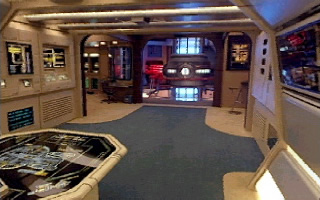Engineering Department is responsible for all power production and distribution systems, propulsion systems and logistics systems (replicators and waste management), as well as transporters and the ship’s hull. Additionally, they share responsibility for the ship’s main computer with Operations Department.

Main Engineering on the USS Hiroshima is a custom-designed third generation Vesta Model II engineering complex, one of the largest currently in use on Federation starships. With a fully functional enhanced diagnostic suite, the Model II variant has two pairings of primary maintenance consoles to either side of the main thoroughfare to complement the banks that are recessed into the walls that were standard in prior models.
A complete engineering operations multi-task station occupies the centre of the deck. Replete with the synopsised data coming through from the ship’s systems, it acts as a quick access point for a variety of functions and is easily configurable. On the Hiroshima several of this station’s consoles are normally set to monitoring damage control operations.
A large amount of space in the Model II variant is taken up by four small storage bays. Designed to hold a variety of key parts in locations closer than a distant cargo bay, these are re-stocked every fortnight due to the high turnover rate experienced on ships of the line.
Located throughout the deck as tool and weapons lockers. Dispersed to increase efficiency, for fear of interfering with hazardous operations they are kept well away from key systems. The only exception to this rule is the primary weapons locker, situated alongside the enhanced diagnostic suite in the event of an emergency combat situation.

Unlike earlier models, the engineering complex on the Hiroshima houses not one but two offices. For administration and management purposes, both the Chief Engineer and the Asst. Chief Engineering Officer have separate workspaces on either side of the complex. Although varying in size and storage space for miscellaneous objects, both offices contain standard desks and independent work stations for the completion of detailed tasks away from the high levels of activity encountered elsewhere on the deck. In addition to this, one entire wall of the Chief Engineer’s office is taken up by a large screen displaying the Hiroshima and all data concerning its systems at that time.
Outside of the two offices there are fifty five work stations in total, of which approximately thirty are manned in emergency situations and other fifteen under normal operations.
ENGINEERING UPPER LEVEL

Considerably smaller than the lower engineering deck, or Main Engineering, during normal operations only three people are required to man the stations, even despite the upper deck containing two primary stations. One is a second operations multi-task position. Unlike its lower counterpart, however, this station is constantly devoted to the maintenance of the Hiroshima’s secondary and reserve functions. The second primary station, located almost directly above the entrance to Main Engineering, handles computer management throughout the entire ship.

In addition to the usual warp core maintenance and power management positions found on most Model II complexes are two multi-purpose suites. On the Hiroshima one is solely devoted to maintaining all systems linked with the mission pod attached at that time while the other acts to supplement whatever tasks are underway in Main Engineering at that time, especially where slipstream, warp and impulse propulsion systems are concerned.
Due to the size of the upper level there is a relatively small number of weapons and tools lockers, and absolutely no storage bays. The tools in question are generally only used in emergency situations where time is of the essence, and the weapons lockers contain a mediocre collection of phaser weaponry at the best of times. As in Main Engineering, however, they are all adequately stocked and kept at conditions of readiness.
